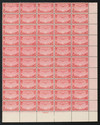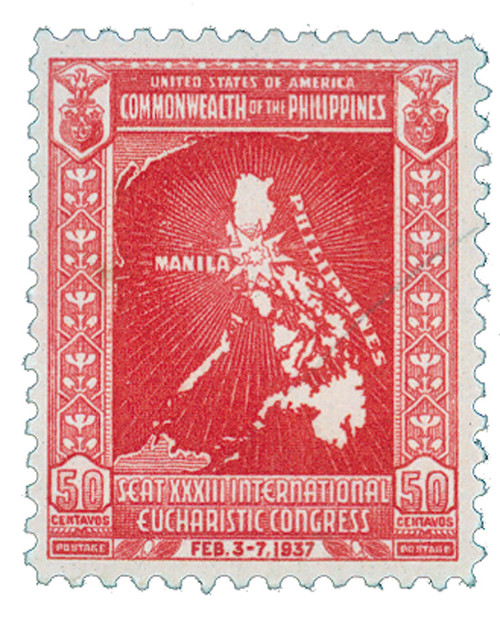
1937 50c Trans-Pacific carmine
# C22 - 1937 50c Trans-Pacific carmine
$3.95 - $675.00
U.S. #C22
1937 20¢ China Clipper
Trans-Pacific Issue
1937 20¢ China Clipper
Trans-Pacific Issue
Issue Date: February 15, 1937
City: Washington, DC
Quantity: 9,285,300
Printed By: Bureau of Engraving and Printing
Printing Method: Flat plate printing
Perforations: 11
Color: Carmine
City: Washington, DC
Quantity: 9,285,300
Printed By: Bureau of Engraving and Printing
Printing Method: Flat plate printing
Perforations: 11
Color: Carmine
On November 22, 1935, airmail across the Pacific Ocean began. A 25¢ stamp (#C20) was issued on the same day to mark the event. It pictured the four-engine Martin M-130 seaplane that flew the inaugural flight. As air travel was still in its early stages, there’s no doubt that this image was both powerful and amazing to many.
The stamp design includes the inscription “November 1935,” making this the first time the month and year of issue was featured on a U.S. stamp. The stamp also pictures the sun rising over the U.S., with an ocean view of a Chinese junk and an ocean liner. The Martin M-130, which departed San Francisco that day, is pictured flying west toward its destinations in Hawaii, Guam and Manila. Also depicted are the shields of the U.S. and the Philippines.
The 25¢ denomination satisfied the rate for mail sent on one leg of the trans-Pacific flight – from San Francisco to Hawaii, Hawaii to Guam, or Guam to Manila. A letter traveling the entire journey required 75¢ postage. Approximately 110,000 covers bearing 75¢ postage – or three #C20 stamps – were carried aboard that historic flight.
Two years later, the service was extended to Hong Kong and China. A green 20¢ and this carmine 50¢ stamp were issued for this service using the same design but minus the “November 1935 inscription. The addition of the China route resulted in the three stamps being nicknamed the “China Clippers.”
U.S. #C22
1937 20¢ China Clipper
Trans-Pacific Issue
1937 20¢ China Clipper
Trans-Pacific Issue
Issue Date: February 15, 1937
City: Washington, DC
Quantity: 9,285,300
Printed By: Bureau of Engraving and Printing
Printing Method: Flat plate printing
Perforations: 11
Color: Carmine
City: Washington, DC
Quantity: 9,285,300
Printed By: Bureau of Engraving and Printing
Printing Method: Flat plate printing
Perforations: 11
Color: Carmine
On November 22, 1935, airmail across the Pacific Ocean began. A 25¢ stamp (#C20) was issued on the same day to mark the event. It pictured the four-engine Martin M-130 seaplane that flew the inaugural flight. As air travel was still in its early stages, there’s no doubt that this image was both powerful and amazing to many.
The stamp design includes the inscription “November 1935,” making this the first time the month and year of issue was featured on a U.S. stamp. The stamp also pictures the sun rising over the U.S., with an ocean view of a Chinese junk and an ocean liner. The Martin M-130, which departed San Francisco that day, is pictured flying west toward its destinations in Hawaii, Guam and Manila. Also depicted are the shields of the U.S. and the Philippines.
The 25¢ denomination satisfied the rate for mail sent on one leg of the trans-Pacific flight – from San Francisco to Hawaii, Hawaii to Guam, or Guam to Manila. A letter traveling the entire journey required 75¢ postage. Approximately 110,000 covers bearing 75¢ postage – or three #C20 stamps – were carried aboard that historic flight.
Two years later, the service was extended to Hong Kong and China. A green 20¢ and this carmine 50¢ stamp were issued for this service using the same design but minus the “November 1935 inscription. The addition of the China route resulted in the three stamps being nicknamed the “China Clippers.”





















